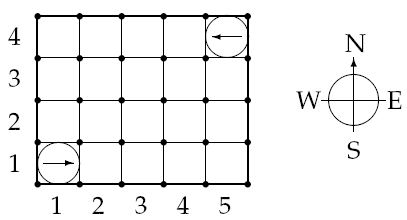POJ 2632 Crashing Robots 模拟
来源:互联网 发布:m12标准螺距怎么编程 编辑:程序博客网 时间:2024/05/20 18:46
Crashing Robots
Time Limit: 1000MS Memory Limit: 65536KTotal Submissions: 6698 Accepted: 2909
Description
In a modernized warehouse, robots are used to fetch the goods. Careful planning is needed to ensure that the robots reach their destinations without crashing into each other. Of course, all warehouses are rectangular, and all robots occupy a circular floor space with a diameter of 1 meter. Assume there are N robots, numbered from 1 through N. You will get to know the position and orientation of each robot, and all the instructions, which are carefully (and mindlessly) followed by the robots. Instructions are processed in the order they come. No two robots move simultaneously; a robot always completes its move before the next one starts moving.
A robot crashes with a wall if it attempts to move outside the area of the warehouse, and two robots crash with each other if they ever try to occupy the same spot.
A robot crashes with a wall if it attempts to move outside the area of the warehouse, and two robots crash with each other if they ever try to occupy the same spot.
Input
The first line of input is K, the number of test cases. Each test case starts with one line consisting of two integers, 1 <= A, B <= 100, giving the size of the warehouse in meters. A is the length in the EW-direction, and B in the NS-direction.
The second line contains two integers, 1 <= N, M <= 100, denoting the numbers of robots and instructions respectively.
Then follow N lines with two integers, 1 <= Xi <= A, 1 <= Yi <= B and one letter (N, S, E or W), giving the starting position and direction of each robot, in order from 1 through N. No two robots start at the same position.

Figure 1: The starting positions of the robots in the sample warehouse
Finally there are M lines, giving the instructions in sequential order.
An instruction has the following format:
< robot #> < action> < repeat>
Where is one of
and 1 <= < repeat> <= 100 is the number of times the robot should perform this single move.
The second line contains two integers, 1 <= N, M <= 100, denoting the numbers of robots and instructions respectively.
Then follow N lines with two integers, 1 <= Xi <= A, 1 <= Yi <= B and one letter (N, S, E or W), giving the starting position and direction of each robot, in order from 1 through N. No two robots start at the same position.

Figure 1: The starting positions of the robots in the sample warehouse
Finally there are M lines, giving the instructions in sequential order.
An instruction has the following format:
< robot #> < action> < repeat>
Where is one of
- L: turn left 90 degrees,
- R: turn right 90 degrees, or
- F: move forward one meter,
and 1 <= < repeat> <= 100 is the number of times the robot should perform this single move.
Output
Output one line for each test case:
Only the first crash is to be reported.
- Robot i crashes into the wall, if robot i crashes into a wall. (A robot crashes into a wall if Xi = 0, Xi = A + 1, Yi = 0 or Yi = B + 1.)
- Robot i crashes into robot j, if robots i and j crash, and i is the moving robot.
- OK, if no crashing occurs.
Only the first crash is to be reported.
Sample Input
45 42 21 1 E5 4 W1 F 72 F 75 42 41 1 E5 4 W1 F 32 F 11 L 11 F 35 42 21 1 E5 4 W1 L 961 F 25 42 31 1 E5 4 W1 F 41 L 11 F 20
Sample Output
Robot 1 crashes into the wallRobot 1 crashes into robot 2OKRobot 1 crashes into robot 2
这道题是一道纯粹的模拟题,灰常简单,只不过有些题难,有些题绕,这道题需要很细心,对于机器人,处理好其位置,放心每次移动进行判断是否碰撞上其他机器人,每个命令执行完毕后判定该机器人是否碰上墙壁,这些方面注意以后这道题就会很容易的AC了,这么简单的题,竟然主页君还WA了一次,不应该啊,主页君第一次WA的主要原因是如果某一步机器人碰到墙壁了,没有阻止让机器人之间的碰撞的判定,造成如果判定之后机器人发生碰撞,记录了之后机器人的碰撞,而没有记录之前机器人撞墙,所以,这道题还是需要细心啊,把问题一修改,这道题立刻就AC了。。。很容易。
下面是AC代码:
#include<cstdio>#include<iostream>using namespace std;int a,b,n;struct robot{int x;int y;int fang;}ro[105];int judgero(int p){int i;for(i=1;i<=n;i++){if(i==p)continue;else{if(ro[p].x==ro[i].x&&ro[p].y==ro[i].y)return i;}}return 0;}int judge(int p){if(ro[p].x>0&&ro[p].y>0&&ro[p].x<=a&&ro[p].y<=b)return 0;return -1;}int main(){int t,i,j,m,p,q,flag,ma;char ch;cin>>t;while(t--){flag=0;cin>>a>>b;cin>>n>>m;for(i=1;i<=n;i++){scanf("%d%d %c",&ro[i].x,&ro[i].y,&ch);if(ch=='N')ro[i].fang=0;else if(ch=='E')ro[i].fang=1;else if(ch=='S')ro[i].fang=2;else if(ch=='W')ro[i].fang=3;}j=0;for(i=0;i<m;i++){scanf("%d %c %d",&p,&ch,&q);if(ch=='L'){while(q--){ ro[p].fang--; if(ro[p].fang<0) ro[p].fang=3;}}if(ch=='R'){while(q--){ ro[p].fang++; if(ro[p].fang>3) ro[p].fang=0;}}if(ch=='F'){while(q--){if(ro[p].fang==0)ro[p].y++;else if(ro[p].fang==1)ro[p].x++;else if(ro[p].fang==2)ro[p].y--;else if(ro[p].fang==3)ro[p].x--;if(j==0){ j=judgero(p); if(j!=0) { flag=j; ma=p; }}}}if(judge(p)==-1&&flag==0){flag=-1;ma=p;j=1;}}if(flag==-1)printf("Robot %d crashes into the wall\n",ma);else if(flag==0)printf("OK\n");elseprintf("Robot %d crashes into robot %d\n",ma,flag);}return 0;}
- POJ 2632 Crashing Robots 模拟
- POJ 2632 Crashing Robots 模拟
- poj 2632 Crashing Robots, 模拟
- POJ 2632-Crashing Robots(模拟)
- POJ 2632 Crashing Robots 模拟
- POJ 2632 Crashing Robots 模拟的方法
- POJ 2632 Crashing Robots 水模拟
- POJ 2632 Crashing Robots(模拟)
- POJ 2632:Crashing Robots:模拟试手
- POJ-2632--Crashing Robots模拟题
- poj 2632 Crashing Robots(模拟)
- POJ 2632 Crashing Robots(模拟题)
- POJ 2632 Crashing Robots(模拟)
- poj-2632-- Crashing Robots -- 模拟法
- POJ-2632-Crashing Robots-模拟题
- POJ 2632 Crashing Robots(简单模拟)
- poj 2632 Crashing Robots(模拟)
- POJ 2632 Crashing Robots 模拟题目
- UVa 10881 Piotr's Ants (等价转化思想)
- 判断文件结束的三种方法(经典)
- MySQL启动方式
- C++ primer 学习记录:面对对象编程之构造函数和复制控制
- Linux下定时器的使用及实现秒以下精确定时与休眠
- POJ 2632 Crashing Robots 模拟
- 安装html5转化为pdf的python库pisa 安装matplotlab把数据转化为图形的python库
- VC中调用外部程序方法: CreateProcess
- Emacs快捷键
- 未处理的异常: 0xC0000005: 读取位置 0x00000000 时发生访问冲突
- POJ1833-排列
- Java教程-Java基础-类的定义与实例化
- Git 入门教程
- lib_base.php on line 346


